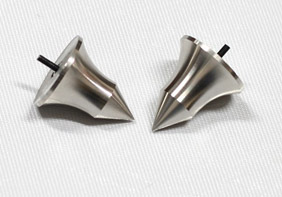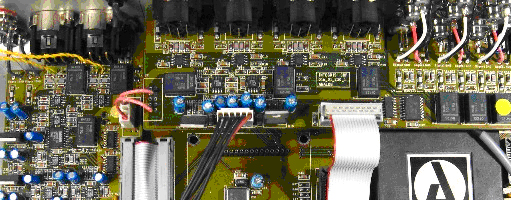Random Noise 08
Random Noise 8

Does paint improve the lily?
To be possess’d with double pomp,
To guard a title that was rich before,
To gild refined gold, to paint the lily,
To throw a perfume on the violet,
To smooth the ice, or add another hue
Unto the rainbow, or with taper light
To seek the beauteous eye of heaven to garnish,
Is wasteful and ridiculous excess.
Shakespeare, The Life and Death of King John
For my original Integris CDP outburst, go to UltraAudio.com’s archives orAurumAcoustics.com. Today’s essay covers an upgrade. Now, an upgrade is always a temptation, particularly when the component’s designer recommends it, but could the spectacularly good Integris possibly sound better? It’s back from its Canadian sojourn, and the answer is – ah, but that would slip the bait from the hook. Read on.
Aurum Acoustic’s Derrick Moss and I have exchanged a lot of emails, and my respect for and reliance on his opinions have only strengthened. He said I’d like what I hear, and…read on. Working from the outside in, we’ll touch briefly on the CDP’s before-and-afters.
 Moss has fashioned a trio of needle-sharp steel spikes to replace, as an option, the unit’s four original rubber feet. The front two screw into the holes the feet occupied. The third sits, centered and unfastened, toward the rear. I wondered whether Moss would tap a rear-center hole in a future production run for the unfastened spike. His reply: “There’s a reason not to secure the rear spike. One theory has it that vibration management works best when one end of the unit is supported differently from the other. I experimented with rear supports and the unsecured spike won out. More trials will ensue, but for now this arrangement sounds best.” Before it left your reporter’s Noble-Pile Domicile, the CDP sat atop the second generation of Silent Running Audio’s only generic isolation platform, the Tremor / Less, to which I had added a quartet of Nordost Quantum Points. (I heartily recommend the T / L and Quantum Points as an effective combination.)
Moss has fashioned a trio of needle-sharp steel spikes to replace, as an option, the unit’s four original rubber feet. The front two screw into the holes the feet occupied. The third sits, centered and unfastened, toward the rear. I wondered whether Moss would tap a rear-center hole in a future production run for the unfastened spike. His reply: “There’s a reason not to secure the rear spike. One theory has it that vibration management works best when one end of the unit is supported differently from the other. I experimented with rear supports and the unsecured spike won out. More trials will ensue, but for now this arrangement sounds best.” Before it left your reporter’s Noble-Pile Domicile, the CDP sat atop the second generation of Silent Running Audio’s only generic isolation platform, the Tremor / Less, to which I had added a quartet of Nordost Quantum Points. (I heartily recommend the T / L and Quantum Points as an effective combination.)
The T / L is nicely finished in a bamboo veneer the CDP’s spearheads would mar. Moss disdains those diminutive pucks that intercede ’twixt surface and spike. SRA’s Kevin Tellekamp doesn’t like them either. As house-proud as the next bourgeois gentilhomme, I was reluctant to disfigure an attractive audio furnishing. A Golden Sound Pad, made of the same tough carbon-fiber composite as Golden Sound’s DH Square, offers a satisfactory alternative. The spikes have found their uncomplaining base. Moss’s thoughts on vibration:
“I’m mainly using speculative analysis to rationalize my findings. The vibes need to be drained out of the component into something that absorbs them. This something should not itself become the means of return-trip vibration. The Golden Sound Pad is a good damping device, presumably a lot better than the cabinet. [The CDP and NuForce Reference 9 SE amps occupy the top of a low wood cabinet.] The spikes are just one aspect of the picture. They permit the vibes to enter the pad below. Their fine points operate as a high-pressure coupling that assist the vibes in crossing the boundary. Make that transition too soft or bouncy, or apply it with inadequate pressure, and the vibes return to their source. Well, sort of….
“Our spike is really a cone. The broad top surface couples well with the bottom of the component. A slender spike would not be as effective. By screwing the front pair on tightly we get better coupling, about the same as increasing the cone’s effective mass several fold. Unthreading this type of spike, where the coupling area is a design feature, in order to adjust component leveling reduces its usefulness. Likewise, securing a cone with two-way tape or something similar decouples the spike from the component. These are no-no’s.
“There’s microanalysis and then there’s the big picture, and you have to identify and address both. We want to optimize the junction of the cone to the component, the cone tip to the supporting damping device, that to the rest of the rack, and then on to the floor. The enemy is the acoustic vibration our speakers produce. Headphone listeners are exempt from this craziness. Most of us don’t understand a tenth of the problem. To carry on about how some footers could be the be-all and end-all of vibration management, likewise a slab, etc., is myopic. A total solution would consist of examining every variable such as a surface-area reduction, adding or increasing mass, damping or stiffness, and creating interface strategies. To that end we have designed our component chassis to address these issues. We’ll use particular spikes, shelves with damping cores, a rack with skeletal connections between shelves, and spikes under the rack connecting to counterpoints that decouple from the floor.”
[Moss is discussing his integrated system, for which, see aurumacoustics.com. There exist two CDP accessories, a $2500 phono stage and $1000 headphone amp, $3300 for both. The CDP now sells in the US for $13,500, the price increase reflecting the weak American dollar. A complete upgrade of an older CDP, such as the one I discuss here, comes to $1500.]
Moss continues: “Vibration’s largest aspect is often the floor. It’s is like a huge mic diaphragm that picks up vibes and transmits them to your components – if you permit that to happen. Interrupting that pathway is a good thing. Spiking your rack to the floor could therefore be a bad thing. The point is, you have to see the whole picture, and I still don’t understand it nearly well enough. So in the end I do only what I hear as being beneficial – as seeming to validate theory. While I’m sure the implementation could be better optimized, there aren’t enough hours in a life to devote to weird science. You have to make your best empirical guesses.”
Moss also increased the value of his audiophile-grade Isoclean fuse from 1A to 3A. He explains: “I suspect it’s the AC power’s 60-Hz cycling that sets a fuse up as a bottleneck. The CDP’s DC fuses are of no sonic consequence. However, with the AC line, we’ve opportunities for the fuse to wreak micro-havoc non-linearities 120 times per second, each 60Hz cycle having two energy delivery envelopes, one positive, the other negative). Because all sonic reproduction comes from the AC source, a cheap, little, oft-forgotten fuse in the power line produces an audible consequence. Larger capacity fuses are less intrusive. Quite simply, I hear the lower-rated fuses as sounding thinner. Maintaining a high margin of headroom in the fuse is good for sonics. On top of that, the Isoleans are the best I’ve heard at the task, better in fact than circuit breakers we’ve tried. Incidentally, I find that most power conditioners do more sonic harm than good, and perhaps this is due to the cheap fuses they use, or other parts that contribute to non-linearities.” The man takes no prisoners.
Other changes include a considerably dimmed standby LED – the one it replaced filled the darkened room with an eerie blue light – and a transport lid that slides even more quietly. As for the CDP’s critically important innards:

“We have replaced all the opamps with a recently developed design significantly better than the best of breed just a year or two ago. In the shallow name of secrecy, I won’t name it. (It isn’t the one that cornered most of this year’s press.) Semiconductor technology has matured to where it’s very, very good. Discrete-circuit fans will of course object, but hey, we evaluate all comers – we’re even into tubes [check out the Web site] – and I’m telling you these opamps are great. As silicon chip capabilities increase, suppliers are doing better things. We also tweaked the power-supply voltages a bit to accommodate the new opamps so that they operate at their optimum.”
Once more, with feeling: does paint improve the lily?
Audio memory is among the most fleeting, and the CDP was gone for a couple of weeks. (Thanks to drug trafficking and the terror threat, commerce between the US and Canada has bureaucratized to a crawl.) But you’re waiting for a judgment, so here goes.
I’m hearing a difference in texture. The perception requires some background. My speakers, the WATT / Puppy’s eighth iteration, employ a tweeter configuration which is said to be an improvement over the W / P 7’s. The CDP, post-upgrade, puts me in touch with the purest upper-midrange-to-treble I’ve yet heard. If that simply means an uptick in resolution, it would also account for a heightened sense of space, location, and musical truth – the necessary aspect behind these observations being, of course, a first-rate recording.
And that brings me to the eighth volume of John Eliot Gardiner’s Bach-cantata series on the Soli Deo Gloria label, www.solideogloria.co.uk. SDG 104 offers two CDs recorded by the Eurosound production team in Unser Lieben Frauen, Bremen and Santo Domingo de Bonaval, Santiago de Compostela. Go figure: Sam Harris’s atheistic polemic, An End of Faith, is one of my favorite books, and I can’t get enough of this superb, inexhaustibly spiritual, death-smitten music. (If the death-reference puzzles you, here’s the translation of an aria for tenor from BWV 95, Christus, der is mein Leben: “Ah, strike then soon, blessèd hour, / your last and final stroke! / Come, come, I extend my arms to you, / come, set an end to my distress / O long desired day of death!” The sentiment runs through a great many of Bach’s church cantatas like a black ribbon.
But the music is superb, and for our purposes ideal: numbers for solo voices, male and female, small and large instrumental combinations, and chorus, all beautifully recorded, reveal subtle differences in the two venues. That’s an accomplishment, particularly when these masterful recordists do their best to get around acoustic dissimilarities. The quality of these Soli Deo Gloria discs, along with that of the upgraded CDP, merely confirms Moss’s decision to concentrate his considerable talents on CD playback. Surely by now none but a handful of philovinylite zealots can seriously suggest that the Red Book medium is congenitally flawed.
A keen sense of space, air, uncluttered detail, opulent harmonic textures (that word again) – in short, the kind of verisimilitude only pure, extended highs, a pristine midrange and taut, tuneful bass can provide have made my recent listening sessions among the most pleasurable I can recall. Perhaps owing to my geezer’s ears, the listening room’s acoustics, and characteristics peculiar to my amps, speakers and cabling, to repeat, the difference I most remark appears to occur in the upper midrange and treble, which sound – if this is possible – more spotlessly clean than ever. Not that I was able to remark deficiencies in the CDP before its departure to Newfoundland and Labrador.
Recommended Recording ![]()
Back when I accumulated Dorian CDs in no systematic fashion, the releases that came my way impressed me with their musically solid performances and top-tier sound. A quick glance at my shelves has put me back in touch, among some others, with Schubert: The Complete Works for Violin and Piano, with Jaime Laredo and Stephanie Brown [DOR 90137, a two-CD set]; and Antonin Kubalik’s Piano Music of Johannes Brahms, Volumes 1 and 2 [DOR 90141 and 90159], recorded in the Music Hall of the Troy Savings Bank, the venue, I believe, for most if not all of Dorian’s releases. At some point in the not too distant past the label went out of business.
 It came, then, as a pleasant surprise to learn of Dorian’s revival as a division of Sono Luminus, headquartered in Winchester, VA. (Adieu, chilly Troy!) For more about that, see www.sonoluminus.com. As for us, I’ve been listening to an absolute charmer entitled Brio / Romance [Dorian DSL 90708]. Brio identifies an instrumental quartet (Steve Rosenberg, recorders, Renaissance and Baroque guitars; Mary Anne Ballard, treble, tenor and bass violas da gamba, and rebec; Danny Mallon, castanets, darbuka, an Arabic tambourine called the riq, frame drums, shakers, wood block, agogo bells; and guest artist Larry Lipkis, viol, recorders, gemshorn.)
It came, then, as a pleasant surprise to learn of Dorian’s revival as a division of Sono Luminus, headquartered in Winchester, VA. (Adieu, chilly Troy!) For more about that, see www.sonoluminus.com. As for us, I’ve been listening to an absolute charmer entitled Brio / Romance [Dorian DSL 90708]. Brio identifies an instrumental quartet (Steve Rosenberg, recorders, Renaissance and Baroque guitars; Mary Anne Ballard, treble, tenor and bass violas da gamba, and rebec; Danny Mallon, castanets, darbuka, an Arabic tambourine called the riq, frame drums, shakers, wood block, agogo bells; and guest artist Larry Lipkis, viol, recorders, gemshorn.)
The quartet’s sounding exotica accompanies a countertenor, José Lemos, in performances of songs from the Sephardic Jewish culture, ranging from Spain to the time of the expulsion in 1492 to the Ottoman Empire, and elsewhere. Taken as a whole, the program’s antique flavor is a good deal more Iberian-Moorish than anything we would recognize as typically Jewish. The texts are in Spanish and Ladino, and Zachary Wilder’s excellent notes provide a rich background to these deliciously subtle, frequently touching performances. Lemos is a delight, likewise the accompaniments. Producer Doug Brown and engineers Brandie Lane and Daniel Schores have provided us with nicely detailed recording in an intimate acoustic appropriate to the music’s scale. Warmly recommended.

![]()
Don’t forget to bookmark us! (CTRL-SHFT-D)
Stereo Times Masthead
Publisher/Founder
Clement Perry
Editor
Dave Thomas
Senior Editors
Frank Alles, Mike Girardi, Key Kim, Russell Lichter, Terry London, Moreno Mitchell, Paul Szabady, Bill Wells, Mike Wright, Stephen Yan, and Rob Dockery
Current Contributors
David Abramson, Tim Barrall, Dave Allison, Ron Cook, Lewis Dardick, Dan Secula, Don Shaulis, Greg Simmons, Eric Teh, Greg Voth, Richard Willie, Ed Van Winkle, and Rob Dockery
Music Reviewers:
Carlos Sanchez, John Jonczyk, John Sprung and Russell Lichter
Site Management Clement Perry
Ad Designer: Martin Perry





Be the first to comment on: Random Noise 08